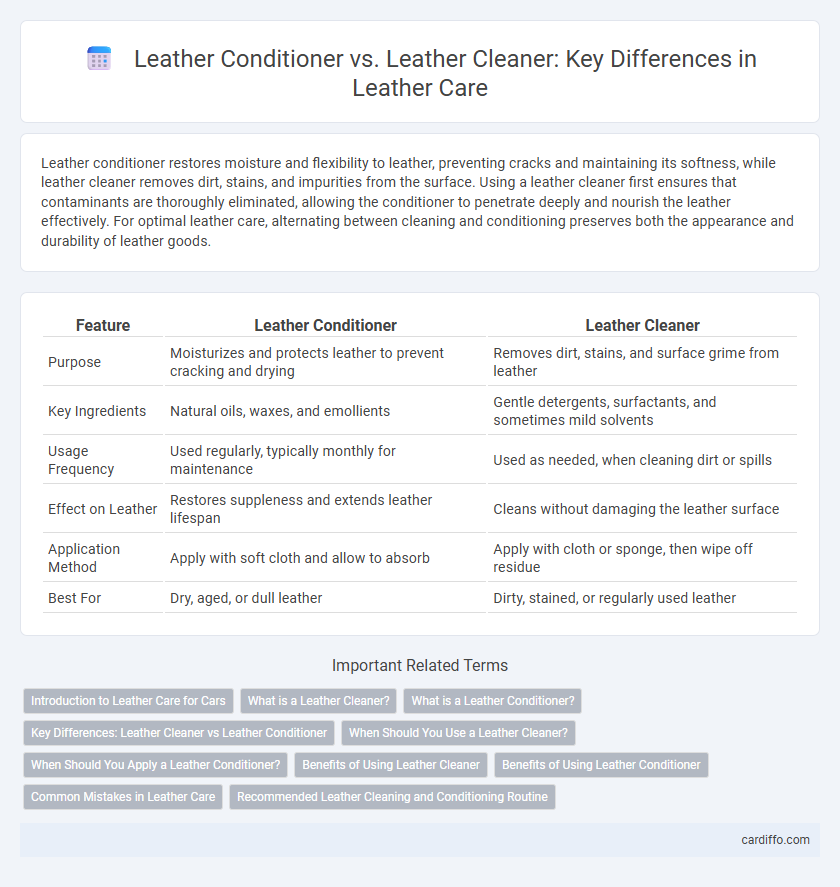Leather conditioner restores moisture and flexibility to leather, preventing cracks and maintaining its softness, while leather cleaner removes dirt, stains, and impurities from the surface. Using a leather cleaner first ensures that contaminants are thoroughly eliminated, allowing the conditioner to penetrate deeply and nourish the leather effectively. For optimal leather care, alternating between cleaning and conditioning preserves both the appearance and durability of leather goods.
Table of Comparison
| Feature | Leather Conditioner | Leather Cleaner |
|---|---|---|
| Purpose | Moisturizes and protects leather to prevent cracking and drying | Removes dirt, stains, and surface grime from leather |
| Key Ingredients | Natural oils, waxes, and emollients | Gentle detergents, surfactants, and sometimes mild solvents |
| Usage Frequency | Used regularly, typically monthly for maintenance | Used as needed, when cleaning dirt or spills |
| Effect on Leather | Restores suppleness and extends leather lifespan | Cleans without damaging the leather surface |
| Application Method | Apply with soft cloth and allow to absorb | Apply with cloth or sponge, then wipe off residue |
| Best For | Dry, aged, or dull leather | Dirty, stained, or regularly used leather |
Introduction to Leather Care for Cars
Leather conditioner nourishes and protects car upholstery by replenishing natural oils, preventing cracks and fading, while leather cleaner effectively removes dirt, stains, and grime from the surface without damaging the material. Proper leather care combines both products to maintain the car's interior appearance, ensuring longevity and a soft, supple finish. Regular maintenance with these specialized products enhances durability and preserves the leather's original texture and color.
What is a Leather Cleaner?
A leather cleaner is a specially formulated product designed to remove dirt, oils, and stains from leather surfaces without causing damage. It typically contains mild surfactants and pH-balanced ingredients that preserve the leather's natural oils and texture. Regular use of leather cleaner helps maintain the material's appearance and prolongs the life of leather furniture, jackets, and accessories.
What is a Leather Conditioner?
A leather conditioner is a specially formulated product designed to moisturize and restore the natural oils in leather, preventing it from drying out and cracking. It penetrates deep into the leather fibers to maintain suppleness, enhance durability, and extend the lifespan of leather goods. Unlike leather cleaners, which remove dirt and stains, leather conditioners focus on nourishing and preserving the leather's texture and appearance.
Key Differences: Leather Cleaner vs Leather Conditioner
Leather cleaner is designed to remove dirt, oils, and stains from leather surfaces without damaging the material, using gentle surfactants to maintain the leather's integrity. Leather conditioner replenishes natural oils and moisture, preventing dryness and cracking by penetrating the leather fibers to restore softness and flexibility. The key difference lies in their purpose: leather cleaners focus on cleaning and removing impurities, while leather conditioners aim to nourish and preserve the leather's durability over time.
When Should You Use a Leather Cleaner?
Use a leather cleaner when your leather item shows visible dirt, stains, or surface grime that cannot be removed by simple wiping. Leather cleaners are specifically formulated to remove contaminants without damaging the natural oils or finish, making them ideal for routine maintenance and preparation before conditioning. Regular use of a leather cleaner ensures the longevity and appearance of leather furniture, car seats, and accessories by keeping the surface fresh and ready for conditioning treatments.
When Should You Apply a Leather Conditioner?
Apply a leather conditioner after thoroughly cleaning the leather surface to restore moisture, enhance flexibility, and prevent cracking. Use conditioner on dry leather that feels stiff, faded, or shows signs of wear to maintain its durability and appearance. Regular conditioning every 3 to 6 months extends leather lifespan and keeps it soft and supple.
Benefits of Using Leather Cleaner
Leather cleaner effectively removes dirt, oils, and stains from leather surfaces, preserving the material's natural texture and appearance. Regular use of leather cleaner prevents the buildup of grime that can cause deterioration, extending the lifespan of leather products. It prepares leather for conditioning by ensuring surfaces are clean and free from contaminants, allowing conditioners to penetrate deeply and work efficiently.
Benefits of Using Leather Conditioner
Leather conditioner enhances the longevity and flexibility of leather by replenishing natural oils, preventing drying and cracking. It maintains the material's softness and rich appearance while providing protection against stains and water damage. Regular use of leather conditioner preserves the leather's durability, ensuring it remains supple and aesthetically pleasing over time.
Common Mistakes in Leather Care
Using leather conditioner instead of leather cleaner on dirty leather can trap dirt and cause damage, as conditioners are meant to moisturize rather than clean. Applying leather cleaner on already conditioned leather may strip away essential oils, leading to dryness and cracking. Many people overlook testing products on a hidden spot, resulting in discoloration or material degradation due to incompatible formulations.
Recommended Leather Cleaning and Conditioning Routine
For optimal leather care, use a leather cleaner first to remove dirt, oils, and stains without damaging the surface, followed by a leather conditioner to replenish moisture and maintain suppleness. Regular cleaning with pH-balanced leather cleaner helps prevent buildup and prolongs the leather's lifespan, while conditioning restores natural oils, preventing cracking and dryness. Experts recommend cleaning leather every 3-6 months and conditioning it at least twice a year to keep leather items looking and feeling their best.
Leather conditioner vs Leather cleaner Infographic

 cardiffo.com
cardiffo.com